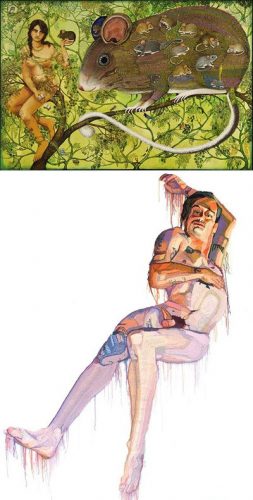
Irene Hardwicke Olivieri and Jo Hamilton may not be native Oregonians, but their art seems to spring from the earthy soul of this region. Both artists’ work has strong ties to craft movements, activism and community (whether that consists of people or animals). Now living in Oregon, Olivieri and Hamilton also both work in a large-scale format and display an immaculate attention to detail. However, their work is wildly different — Olivieri creates nature-infused oil paintings and Hamilton constructs urban “crochet paintings” of people and cityscapes.
Curators June Black and Jessi DiTillio brought the two together for Oregon Contemporary Visions, one of the most exciting contemporary exhibits to come to the Jordan Schnitzer Museum of Art, running through Aug. 3. Learn more about the work and the artists when they give a joint artist talk 5:30 pm Wednesday, April 16, in the Harold and Arlene Schnitzer Gallery.
Closer to Wildness — Irene Hardwicke Olivieri
“After 15 years living on the East Coast, I found myself yearning to live in a wilder place, to be closer to nature in a more ancient and vulnerable way,” Olivieri, a Texas native, tells me over the phone from her “off-the-grid” home in central Oregon. It’s clear she thrives in the natural environment — her paintings feature a dizzying array of flora and fauna: a reclining nude woman in a cougar’s belly (“Valentine for a cougar”); Giuseppe Arcimboldo-like portraits constructed from ferns, caterpillars, pea pods and berries (“Some kind of wilderness”); and, of course, her beloved packrats.
“When I moved to Oregon about nine years ago, I became acquainted with a truly extraordinary creature — the bushy-tailed woodrat,” she says (packrat is the colloquial name). “Packrats are nature’s little folk artists, always searching for interesting items to bring back to their nest.” In the enormous painting “I drop everything when I see you” (it has its own wall at the Schnitz), a nude woman sits in a tree canopy with a human-sized packrat whose body is covered with smaller packrats surrounded by delicate painted text — a common tool in her work — that describes the lives and habits of these fuzzy critters.
Animal activism is perhaps the strongest current in her work and life. Olivieri was one of the founders of the action arm of TrapFree Oregon, and she looks to Brooks Fahy, director of Eugene-based Predator Defense, as inspiration. “While some people seem to want to trap and get rid of these beautiful creatures, there are many creative ways to coexist with our wild friends and greatly enrich our lives in doing so,” she says. In fact, Olivieri has done just that — a tamed packrat that she named “Pedro” lives under her deck. She feeds him peanuts and Pedro once stole her paintbrush.
To learn more about Olivieri’s work, read her painting descriptions in her new book Irene Hardwicke Olivieri: Closer to Wildness, which will be available at the JSMA.
The Urban Environment — Jo Hamilton
“My mom and my gran were both knitters and crocheters and women who made things,” Hamilton says in her lilting Scottish accent during a phone call from Portland. “I learned to knit and crochet when I was really young.” Hamilton came to Oregon by way of Glasgow, where she grew up and attended the Glasgow School of Arts to study oil painting. But painting left her wanting.
“I was still kind of hunting for something else,” she says. It wasn’t until after she followed some friends to Portland in the ’90s that she found out what she was hunting for: to combine representational “high” art with her love of crochet. And thus, after several years of knuckle-busting work, one of her most iconic works was born — “I Crochet Portland,” a colorful mass of yarn that captures Hamilton’s personal Portland. During that period, at the prodding of her co-workers at Le Pigeon Restaurant, Hamilton completed 12 portraits of her fellow employees.
One of Hamilton’s most astounding and ambitious portraits, on view at the Shnitz, is “Bridging Shine,” a goliath of that classic art form the nude.
“It was quite terrifying to make at first,” she says. “I didn’t know if I could do it.” She did and it works. This portrait, as well as her others, have a fleshy, painterly realism, which is a huge feat considering her materials: thrift store yarn and, sometimes, plastic bags. And she’s not trying to mask these materials as something they’re not; Hamilton purposely leaves the threads dangling from the edges of her work to show viewers “how much goes into it,” which can be hours, weeks or even years.
“Having more experience doesn’t make it any faster,” Hamilton says. “I’m just less hesitant now.”
Jo Hamilton received an Oregon Arts Commission grant to produce a catalog , Jo Hamilton: Selected Works 2006-2014, for this exhibit; look for it at the JSMA.